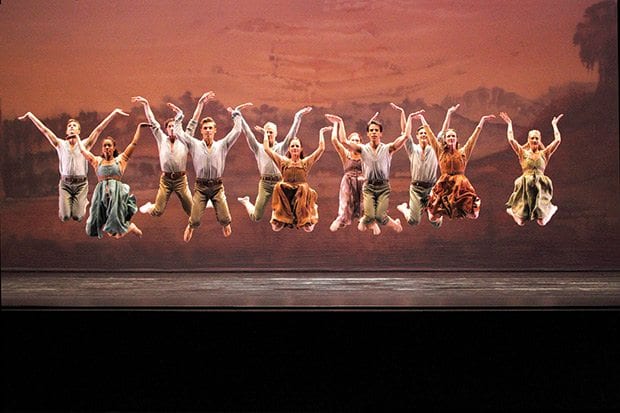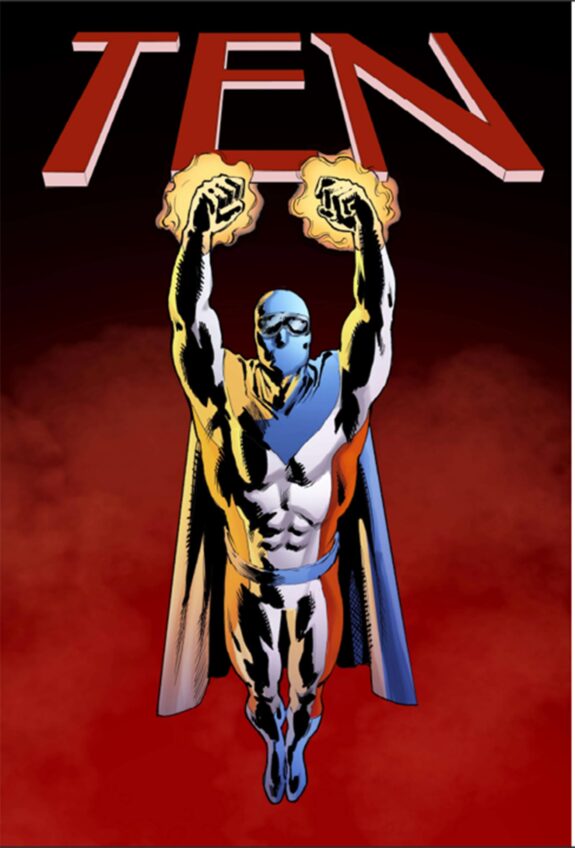
Late last month, Boston was treated to a world-class performance when the Paul Taylor Dance Company held its audience spellbound at the first of its three performances in the Shubert Theatre, a presentation of the Celebrity Series of Boston.
Since 1954, Taylor, 84, the New York company’s choreographer and founding artistic director has been known for high-spirited, muscular dances that are true to human nature. With masterly staging as well as fluid, expressive movement that breathes with the music, Taylor is among the handful of pioneers who reinvented dance, freeing an art form shackled in centuries of tradition with revolutionary American energy.
The three-part program began with the Boston premiere of Taylor’s 2013 work, “Perpetual Dawn,” set to German baroque music of the 17th century. Evoking the same period, Santo Loquasto designed the backdrop, a dreamy countryside scene that resembles a painting by Antoine Watteau, and the rustic costumes in pale earth tones worn by the dancers, six men and five women. Warmly lit by James F. Ingalls, the dance unfolds like a painting come to life.
Its subject is the titillating and vulnerable experience of first love. From the first moment, a duet between two men who hold hands and mirror each other’s leg lifts, the dance playfully echoes traditions of classical ballet. Men, as well as women, pirouette and leap with earthy gusto and freeze mid-motion like stick figures. Injecting a bit of social satire, the females gather to titter with gossip and the men huddle to rally one another.
Sweet but never saccharine, the work builds in the robust geometry of country dancing and its flowing interplay of pairs, trios, circles and lines. Moments of quirky intimacy also find their way, such as Michelle Fleet’s irked female, who seeks a partner; and a tender duet by Eran Bugge and Francisco Graciano that radiates the joy of coupling.
The program quotes a poem by Emily Dickinson conjuring a moment in which time stands still in an endless dawn. As the curtain falls, the dancers’ legs and feet continue to move, as if in an endless dance.
In Taylor’s riveting and austere “Private Domain” (1969), a score by Iannis Xenakis for strings, horns and percussion creates music without melody, while an ensemble of three men and five women performs stop-and-start movements suggestive of sex without love.
Known for sleek, semi-abstract portraits, painter Alex Katz designed the spare set and body-baring costumes — navy swim trunks for the men and shimmering aquamarine two-piece bathing suits for the women. Three vertical panels divide the stage like pillars and create a hide-and-see effect. At times obscuring dancers’ limbs, the panels guarantee that no two people see the same performance as the dancers pose, tumble and enfold one another with cool intensity.
All 13 dancers take feature roles in “Black Tuesday” (2001), a Taylor masterpiece that resurrects eight songs from the Great Depression. They portray a gallery of people whose makeshift ballroom is the base of a Manhattan bridge. Santo Loquasto’s soaring backdrops and Jennifer Tipton’s lighting reflect the mood of each song. The costumes, also by Loquasto, cloak the dancers in tattered elegance — from the men’s worn vests and sagging jackets to brooch-laden hats and flouncy dresses that let the women shimmy with jitterbug joy. These people may be penniless but they have style.
Like two happy hoboes, Michael Apuzzo and Michael Novak dance a high-kicking music hall-style number to “Underneath the Arches.” George Smallwood, in sailor’s garb, smoothly partners with glamorous Laura Halzack for a euphoric duet to “There’s No Depression in Love.” Then, the ensemble returns and rotating like a human merry-go-round, the dancers end the song in a giddy high.
Backed by a silhouette of skyscrapers, Michelle Fleet and James Samson project defiant glamour as they glide to the swinging “Slummin’ on Park Avenue.” The mood darkens a bit despite the high energy and fantastic footwork of Kristi Tornga’s solo to “Sittin’ on a Rubbish Can.” Dancing to this song of desperate loneliness, she plays the part of a pregnant girl.
Taylor’s pull-no-punches choreography conveys pain and brutality, as well as beauty and joy. The suite takes an even grittier turn with the song “Are You Making Any Money?” Large-boned Robert Kleinendorst, outfitted like a dandy and brandishing a foot-long cigar, leads his trio of prostitutes, Eran Bugge, Aileen Roehl, and Heather McGinley, who convey reluctant submission with their bodies. At one point, he climbs on their backs.
Left behind by the group, McGinley performs a solo to “The Boulevard of Broken Dreams,” venting anguish through her long arms and legs.
Playing the part of a newsboy who dreams of vanquishing the Depression, Jamie RaeWalker bursts with bravado in her propulsive solo to the jaunty tune, “I Went Hunting and the Big Bad Wolf Was Dead.”
Handsome and athletic, Michael Trusnovec dances the role of a World War I veteran who proudly worked on building projects but now cannot earn a living. His solo elevates the Depression anthem “Brother Can You Spare a Dime?” into a timeless poem of striving and yet hitting bottom. Leaping against a backdrop of stars, he endows his destitute character with a hero’s dignity.






